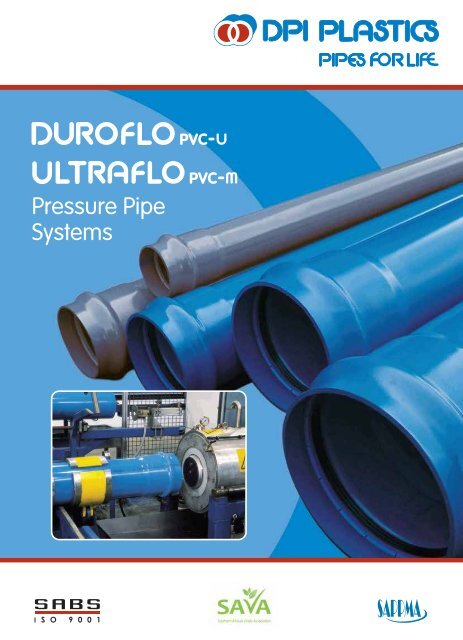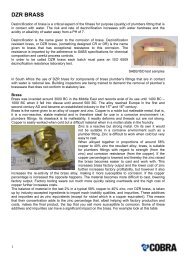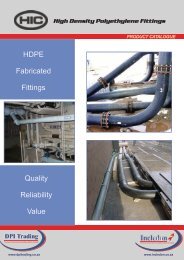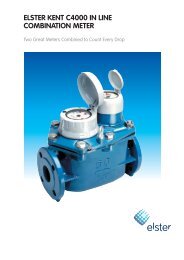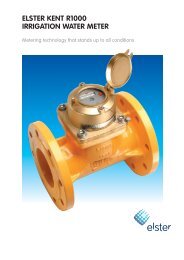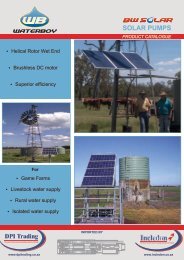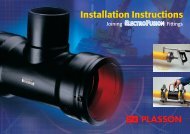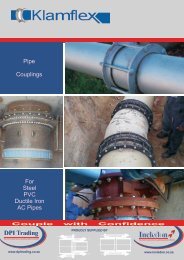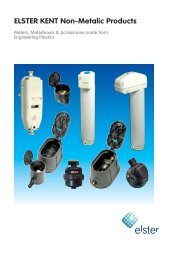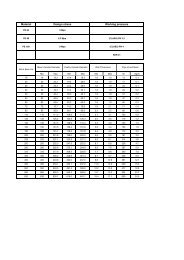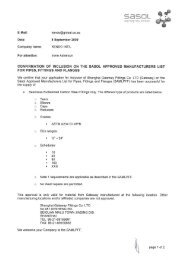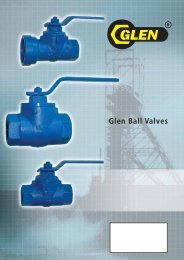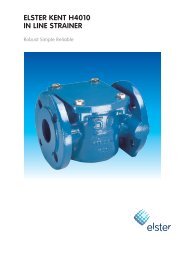DPI Plastics Pressure Catalogue - Incledon
DPI Plastics Pressure Catalogue - Incledon
DPI Plastics Pressure Catalogue - Incledon
You also want an ePaper? Increase the reach of your titles
YUMPU automatically turns print PDFs into web optimized ePapers that Google loves.
1<br />
INTRODUCTION<br />
<strong>DPI</strong> <strong>Plastics</strong> (Pty) Ltd is a leading manufacturer of PVC and HDPE<br />
water reticulation and drainage pipe and fitting systems with two ISO<br />
9001 certified South African factories based in Johannesburg and<br />
Cape Town. In addition, within the <strong>DPI</strong> Group are wholly owned<br />
subsidiary plants in Namibia and Botswana and joint venture (JV)<br />
manufacturing operations in Mauritius, Tanzania and Angola,<br />
producing plastic pipes to the relevant SABS or international<br />
specification.<br />
<strong>DPI</strong> is wholly-owned by industry leader Dawn, which is listed in the<br />
construction, building materials and fixtures sector of the JSE.<br />
The group’s strategy is centred on the manufacturing and wholesale<br />
distribution of local and international quality branded hardware,<br />
sanitaryware, plumbing, kitchen, engineering and civil products<br />
through a national, strategically-positioned branch network, as well<br />
as in selected African countries.<br />
<strong>DPI</strong> <strong>Plastics</strong>’ products and related components are sold to the rest of<br />
Africa via the Exports Department based in Johannesburg, as well as<br />
through relationships with AST International and Saffer International,<br />
each with offices of their own across the continent.<br />
WHY PVC FOR PRESSURE APPLICATIONS<br />
PVC pressure pipe systems, including Duroflo and Ultraflo, offer many advantages when compared to<br />
traditional products, namely:<br />
• Enhanced hydraulic performance.<br />
• Durability and toughness – resistance to<br />
handling and installation damage.<br />
• Corrosion resistance – greater service life.<br />
• Lower mass – ease of handling and installation,<br />
particularly suited to labour intensive projects.<br />
• Locked-in sealing ring system – no specialist<br />
installation skills required.<br />
• Savings on installation time.<br />
• Manufactured within internationally accepted<br />
standards.<br />
• Highly recyclable - Waste generated during<br />
manufacturing is pulverized and reprocessed<br />
• Savings on transport costs.<br />
• Service performance in excess of 50 years.<br />
• Unique combination of properties<br />
- Toughness<br />
- Stiffness<br />
- High tensile and hoop strength<br />
- Excellent resistance to creep<br />
• Predictable long-term behaviour.<br />
• Energy efficient - PVC pipe production<br />
consumes less energy during manufacturing<br />
than steel, clay or ductile iron<br />
PVC PRESSURE PIPE SPECIFICATIONS<br />
The SANS 966 is a two-part specification.<br />
DUROFLO<br />
Part 1: Unplasticised Poly Vinyl Chloride<br />
(PVC-U) <strong>Pressure</strong> Pipe Systems<br />
SANS 966 Part 1 (PVC-U)<br />
ULTRAFLO<br />
Part 2 : Modified Poly Vinyl Chloride<br />
(PVC-M) <strong>Pressure</strong> Pipe Systems<br />
SANS 966 Part 2 (PVC-M)<br />
DUROFLO PVC-U<br />
ULTRAFLO PVC-M<br />
MATERIAL Unplasticised Polyvinyl Chloride Modified Polyvinyl Chloride<br />
PIPE SANS 966 Part 1 SANS 966 Part 2<br />
SEAL RINGS SANS 4633 SANS 4633<br />
BENDS SANS 966 Part 1 SANS 966 Part 2<br />
FACTORIES ISO 9001 ISO 9001<br />
Diameter<br />
PVC pressure pipes are specified by their nominal<br />
size (i.e. outside diameter) in millimetres. For design<br />
purposes, reference should be made to tables<br />
detailing the internal diameters as calculated from the<br />
average wall thicknesses of the particular pressure<br />
class of pipe.<br />
<strong>Pressure</strong> Class<br />
A range of pressure “classes” is available in each size.<br />
These classes are based on the pipe’s recommended<br />
maximum working pressure in kPa.<br />
For example, a class 16 pipe has a recommended maximum<br />
working pressure of 1 600kPa, or 160 metres head.
DUROFLO PVC-U <strong>Pressure</strong> Pipe<br />
2<br />
Duroflo unplasticised PVC (PVC-U) pressure pipe is a tried and tested system demonstrating a long track<br />
record in the water reticulation sector. Duroflo pressure pipes are manufactured to the SANS 966 Part 1<br />
specification, incorporating the traditional design stresses of 10 and 12.5 MPa. The product is ideally suited to<br />
applications in both pumping and gravity designs.<br />
Product Range<br />
• <strong>Pressure</strong> Classes 4, 6, 9, 12, 16 and 20 Bar.<br />
• Working <strong>Pressure</strong>s 400, 600, 900, 1 200, 1 600 and 2 000 kPa.<br />
• Length Supplied in standard 6m lengths.<br />
• Outside Diameters Constant for all classes of a given size.<br />
966 - Part 1<br />
• Pipe Ends / Joints Spigot and socket pipe with integral socket and locked-in rubber ring seal.<br />
Dimensions<br />
Minimum wall thickness and mass per 6-metre length for each size and class.<br />
(Wall thickness = mm / Mass = kg )<br />
Outside<br />
Class 4 Class 6 Class 9 Class 12 Class 16 Class 20<br />
Dia.mm mm kg mm kg mm kg mm kg mm kg mm kg<br />
16 - - - - - - - - 1.5 0.62 - -<br />
20 - - - - - - - - 1.5 0.79 - -<br />
25 - - - - - - 1.5 1.01 1.9 1.25 - -<br />
32 - - - - 1.5 1.31 1.8 1.55 2.4 2.03 - -<br />
40 - - 1.5 1.65 1.8 1.96 2.3 2.47 3.0 3.16 - -<br />
50 1.5 2.08 1.8 2.48 2.2 3.00 2.8 3.77 3.7 4.88 - -<br />
63 1.5 2.63 1.9 3.31 2.7 4.64 3.6 6.09 4.7 7.80 - -<br />
75 1.5 3.15 2.2 4.57 3.2 6.56 4.3 8.67 5.6 11.07 - -<br />
90 1.8 4.53 2.7 6.73 3.9 9.58 5.1 12.34 6.7 15.89 - -<br />
110 2.2 6.77 2.6 8.14 3.9 12.11 5.1 15.67 6.7 20.29 8.2 24.48<br />
125 2.5 8.91 3.0 10.66 4.4 15.53 5.8 20.25 7.6 26.15 9.3 31.55<br />
140 2.8 11.19 3.3 13.19 4.9 19.37 6.5 25.41 8.5 32.75 10.4 39.51<br />
160 3.2 14.64 3.8 17.36 5.6 25.32 7.4 33.10 9.7 42.76 11.9 51.73<br />
200 3.9 22.40 4.7 26.92 7.0 39.68 9.2 51.62 12.1 66.92 14.9 81.24<br />
250 4.9 35.33 5.9 42.46 8.7 62.68 11.5 81.12 15.1 105.03 18.6 127.58<br />
315 6.2 56.44 7.4 67.28 11.0 99.04 14.5 129.29 19.0 167.12 - -<br />
355 7.0 72.19 8.4 86.55 12.4 126.57 16.3 164.83 21.4 213.49 - -<br />
400 7.9 90.90 9.4 109.40 14.0 161.41 18.4 210.21 - - - -<br />
450 - - 10.6 139.39 15.7 204.60 - - - - - -<br />
500 - - 11.8 172.59 17.4 252.34 - - - - - -<br />
560 11.0 182 13.2 217 19.5 318 - - - - - -<br />
630 12.5 232 14.8 274 21.9 401 - - - - - -<br />
Note:<br />
1. The wall thicknesses for pipe diameters 90mm and<br />
below, including the entire class 4 pressure range,<br />
are based on a design stress, O s<br />
of 10MPa and an<br />
overall service (design) coefficient (or safety factor)<br />
of C = 2.5.<br />
2. Wall thicknesses for pipe diameters from 110mm<br />
are based on a design stress, O s<br />
of 12.5MPa and<br />
an overall service (design) coefficient (or safety factor)<br />
of C=2.0.
3<br />
ULTRAFLO PVC-M <strong>Pressure</strong> Pipe<br />
Ultraflo PVC-M is a tough and resilient, modified PVC pressure pipe, developed to offer greater strength<br />
and toughness. Ultraflo pressure pipes are manufactured in accordance with the SANS 966 Part 2<br />
specification, incorporating a design stress of 18MPa.<br />
Product Range<br />
• <strong>Pressure</strong> Classes 6, 9, 12, 16, 20 and 25 Bar.<br />
• Working <strong>Pressure</strong>s 600, 900, 1 200, 1 600, 2 000 and 2 500 kPa.<br />
• Length Supplied in standard 6m lengths.<br />
• Outside Diameter Constant for all classes.<br />
• Pipe Ends / Joints Spigot and socket pipe with integral socket and locked-in rubber ring seal.<br />
Dimensions<br />
Minimum wall thickness and mass per 6-metre length of each size and class.<br />
(Wall thickness = mm / Mass = kg )<br />
966 - Part 2<br />
Outside<br />
Dia.mm<br />
Note:<br />
Class 6 Class 9 Class 12 Class 16 Class 20 Class 25<br />
mm kg mm kg mm kg mm kg mm kg mm kg<br />
50 1.5 2.1 1.5 2.1 1.7 2.4 2.2 3.0 2.7 3.7 3.3 4.4<br />
63 1.5 2.7 1.6 2.8 2.1 3.7 2.7 4.7 3.4 6.0 4.1 7.0<br />
75 1.5 3.2 1.9 4.0 2.5 5.3 3.2 6.8 4.0 8.2 4.9 10.0<br />
90 1.8 4.6 2.2 5.6 3.0 7.6 3.9 9.7 4.8 11.9 5.9 14.4<br />
110 2.2 6.9 2.7 8.4 3.6 11.1 4.7 14.4 5.8 17.6 7.2 21.5<br />
122 - - - - 4.0 13.3 5.2 17.2 - - - -<br />
125 2.5 8.9 3.1 11.0 4.1 14.4 5.4 19.1 6.6 22.7 8.2 27.9<br />
140 2.8 11.2 3.5 14.2 4.6 18.1 6.0 24.1 7.4 28.6 9.1 35.8<br />
160 3.2 14.6 4.0 18.2 5.2 23.5 6.9 30.8 8.5 37.6 10.4 45.5<br />
177 - - - - 5.8 28.1 7.7 36.8 - - - -<br />
200 3.9 22.3 4.9 27.9 6.5 36.8 8.6 48.2 10.6 60.3 13.0 71.3<br />
250 4.9 35.1 6.1 44.9 8.1 57.6 10.7 75.4 13.2 94.6 16.3 112.5<br />
315 6.2 56.3 7.7 69.7 10.2 91.7 13.5 120.3 16.6 146.7 - -<br />
355 7.0 72.0 8.7 89.2 11.5 117.3 15.2 153.6 - - - -<br />
400 7.8 90.3 9.8 113.5 13.0 149.8 17.1 195.4 - - - -<br />
450 8.9 116.7 11.0 144.0 14.6 190.1 - - - - - -<br />
500 9.8 144.4 12.2 177.7 16.2 234.8 - - - - - -<br />
560 11.0 182 13.5 222 17.1 280 23.4 378 - - - -<br />
630 12.5 232 15.4 285 20.4 375 26.9 489 - - - -<br />
1. Wall thicknesses for PVC-M pipes are based on a design stress, O s<br />
of 18MPa and an overall service (design) co-efficient (or safety<br />
factor) of C = 1.4.<br />
DESIGN COEFFICIENT (SAFETY FACTOR)<br />
Product<br />
Duroflo PVC-U (16-90mm)<br />
(110-630mm)<br />
Ultraflo PVC-M<br />
(50-630mm)<br />
Design<br />
stress<br />
Design coefficient<br />
1 hour 50 years<br />
10 MPa 4.2 2.5<br />
12.5 MPa 3.4 2.0<br />
18.0 MPa 2.3 1.4
FITTINGS<br />
PVC pressure pipes are compatible with standard SG iron fittings and a range of PVC fittings.<br />
4<br />
SG Iron Valves and Fittings<br />
A complementary range of valves and fittings is available.<br />
The fittings are socketed and manufactured in SG iron grade 42 to suit PVC pipe in<br />
sizes up to 315mm. They are either bitumen dipped or fusion bonded epoxy powder<br />
coated to prevent corrosion.<br />
Valves include: Resilient seated Gate valves –<br />
either Socketed or Flanged, for pressure rating of PN10/PN16 and in sizes up to<br />
DN300; Double Door Check Valves for PN16 pressure ratings in sizes up to<br />
DN200; Spring loaded Swing Check Valves for PN16 pressure ratings and in<br />
sizes up to DN200; Fire Hydrants with either London Round or Bayonet outlets;<br />
Wafer Pattern Rubber Lined Butterfly Valves for PN16 pressure ratings and<br />
in sizes up to DN300 and; Inline Strainers in sizes up to DN200. Valves are<br />
manufactured as standard in SG iron, fusion bonded epoxy powder coated<br />
with stainless steel trim.<br />
PVC <strong>Pressure</strong> Bends<br />
Both PVC-U and PVC-M pressure bends are manufactured to class 9 and class 16 working pressures. Bends to<br />
class 25 can be manufactured on request. The range of bends is available in 11.25˚, 22.5˚, 45˚ and 90˚.<br />
Steel Fabricated Fittings<br />
For sizes 315, 355, 400, 450 and 500mm plain ended steel fabricated bends, equal tees, hydrant and scour<br />
tees, reducing tees, reducers, flanged adaptors, end caps and saddles are available. These fittings are suitably<br />
protected against corrosion.<br />
“Viking Johnson” or similar couplings are used to connect these fittings to plain ended pipe. The “Viking Johnson”<br />
joint is a mechanical joint in which a rubber seal is compressed against the pipe spigots by tightening the bolts<br />
on the joint. The correct “barrel” length of the “Viking Johnson” joint must be used to allow for expansion and<br />
contraction of the PVC pipe or any possible movement after installation of the pipeline. The PVC pipe spigots<br />
must also be cut square to the axis of the pipe before making the joint. It must be noted that these joints offer little<br />
resistance to end thrust which occurs at bends, flanges, valves, etc.; consequently the pipe should be adequately<br />
anchored.<br />
Steel Fabricated Fittings<br />
PVC <strong>Pressure</strong> Bends<br />
and fabricated fittings<br />
PIPE MARKING<br />
The following information appears on all PVC pressure pipe, manufactured in accordance with the SABS specifications:<br />
• SABS Mark.<br />
• SABS Specification number.<br />
• Nominal pipe size.<br />
• <strong>Pressure</strong> class.<br />
• The designation “PVC-U” or “PVC-M”.<br />
• Manufacturer’s trade name or trade mark.<br />
• Batch identification number that provides traceability of the product, with the date and time of manufacture.<br />
• SAPPMA logo: a quality mark from the Southern African Plastic Pipe Manufacturers Association over and above<br />
the relevant SABS or international mark, indicating a responsible manufacturer of integrity and a quality<br />
product backed by a technical information service. SAPPMA is an affiliated member of the <strong>Plastics</strong> Federation<br />
of South Africa.
5<br />
INSTALLATION<br />
EXCAVATION<br />
The width of the trench excavation should be kept to a minimum, allowing just sufficient working area for jointing<br />
and initial compaction around the pipe. For most purposes, a trench 300mm wider than the diameter of the pipe<br />
allows enough room for jointing. It is important that the trench is not excavated too far in advance of the pipe<br />
laying operation, especially in situations where the trench walls are unstable.<br />
BEDDING<br />
The quality of the bedding material and its compaction, together with the nature of the undisturbed material of<br />
the trench walls are all relevant to the ultimate performance of Duroflo and Ultraflo pressure pipes once installed.<br />
The trench bed must be free from all stones or sharp projections which are likely to cause damage to the pipe.<br />
The bottom of the trench should be backfilled to a depth of 100mm, with selected bedding material such as free<br />
draining coarse sand, gravel or soil of a friable nature. The size of soil particles in the bedding material should<br />
not exceed 20mm. The bedding onto which the pipe is laid, should be thoroughly compacted to the specified<br />
density. Reference should be made to SANS 2001 for bedding specifications.<br />
BACKFILLING<br />
It is essential that each length of PVC pressure pipe is backfilled immediately after installation in order to contain<br />
expansion and contraction that may occur in an open trench. All joints must be left exposed at this stage.<br />
Selected backfill material should be placed in consecutive even Comparitive layers of 150mm Assembly in depth over Forces the entire width<br />
of the trench to a height of 300mm above the crown of the pipe. All layers must be firmly tamped by hand. The<br />
remainder of the trench should be filled in layers of 300mm in depth. Excavated trench material may be used.<br />
Each layer must be firmly compacted, the first layer by hand and subsequent layers by mechanical means if<br />
needed.<br />
ANCHORING<br />
When an internal hydrostatic pressure is applied to the<br />
pipe, unbalanced forces develop at all changes of size<br />
and direction in a pipeline. Thrust blocks prevent the<br />
movement of fittings and must be placed at all changes<br />
of direction, valves, stop ends and reducers. Concrete<br />
thrust blocks are most commonly used at all anchor<br />
points. The dimensions of the thrust blocks must be<br />
calculated to suit the pipe diameter, pressure and the<br />
load bearing capacity of the soil.<br />
Typical Thrust Block Sizes<br />
(Final dimensions must be specified by the<br />
consulting engineer)<br />
Pipe<br />
Size<br />
(mm)<br />
90˚ Bends<br />
A x B<br />
(m)<br />
45˚ Bends<br />
A x B<br />
(m)<br />
Tees<br />
A x B<br />
(m)<br />
End Caps,<br />
Valves,<br />
Reducers<br />
A x B<br />
(m)<br />
110 0.30 x 0.30 0.30 x 0.25 0.30 x 0.30 0.30 x 0.60<br />
200 0.45 x 0.70 0.30 x 0.70 0.45 x 0.60 0.45 x 0.80<br />
315 0.60 x 1.30 0.60 x 0.90 0.60 x 0.90 0.60 x 1.00<br />
400 1.00 x 1.60 1.00 x 1.20 0.80 x 1.50 0.80 x 1.50<br />
CUTTING TO LENGTH<br />
When cutting PVC pressure pipe, clearly mark the cutting<br />
position on the pipe, ensuring that the cut is square to the<br />
axis of the pipe. Use a fine-toothed wood saw or power<br />
saw to cut the pipe. Remove all swarf and burrs from the<br />
cut end and chamfer the pipe with a fine to medium file, at<br />
15˚ to half of the pipe wall thickness. Redraw the depth of<br />
entry mark.
6<br />
900mm<br />
DETAILED PIPELINE DESIGN TECHNICAL INFORMATION<br />
CONTAINED IN CD OR PDF FORMAT<br />
Available on request from <strong>DPI</strong> <strong>Plastics</strong> and containing, inter alia:<br />
• Design criteria and specific considerations<br />
• Water hammer and surge<br />
• Temperature effects<br />
• Effect of entrapped air<br />
• Longitudinal bending<br />
• Friction and velocity calculation tables
Mineflo PVC-M <strong>Pressure</strong> Pipe<br />
Duroflex Flexible PVC Hose<br />
Rainflo PVC D-shape Gutter System<br />
Polydrain HDPE Double Wall Drainage Pipe<br />
Johannesburg Tel: +27 11 345 5600 Cape Town: +27 21 957 5600 www.dpiplastics.co.za<br />
headoffice@dpiplastics.co.za pe@dpiplastics.co.za bloem@dpiplastics.co.za exports@dpiplastics.co.za<br />
bellville@dpiplastics.co.za george@dpiplastics.co.za durban@dpiplastics.co.za info@dpiplastics.co.za


